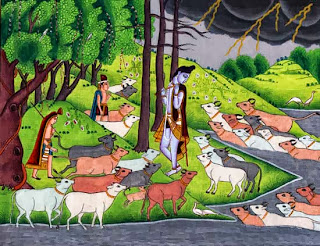 Krishna
was a naughty child and his pranks were at once the despair and delight of his
mother and the neighbors. He would steal the butter and break the churning
vessel, and all his mother's attempts to punish him came to naught. One day,
Krishna, like most children in the village, was found eating earth. When
Yashoda reprimanded him, he denied having done so. On this she asked him to
open his mouth. When he did so she saw numberless suns and moons, planets and
stars, oceans and continents, mountains and rivers, and in fact the entire
Universe. Unable to bear the revelation, Yashoda closed her eyes, and bowed her
head before his feet, realizing that her son was none other than Vishnu
himself. The gods, however, drew over her sight the veil of illusion, and she
again felt that the child in front of her was only her own son.
Krishna
was a naughty child and his pranks were at once the despair and delight of his
mother and the neighbors. He would steal the butter and break the churning
vessel, and all his mother's attempts to punish him came to naught. One day,
Krishna, like most children in the village, was found eating earth. When
Yashoda reprimanded him, he denied having done so. On this she asked him to
open his mouth. When he did so she saw numberless suns and moons, planets and
stars, oceans and continents, mountains and rivers, and in fact the entire
Universe. Unable to bear the revelation, Yashoda closed her eyes, and bowed her
head before his feet, realizing that her son was none other than Vishnu
himself. The gods, however, drew over her sight the veil of illusion, and she
again felt that the child in front of her was only her own son.
When
sins multiply, Vishnu reincarnates himself to rid the earth of its calamities.
Krishna is regarded as the eighth incarnation of Vishnu, and the legends
relating to him are found in the Bhagavata Purana and its Hindi version, the
Prom Sagara.
There
are many distinct elements in the Krishna legend which indicate that it is of
composite origin. Thus, there is Krishna, the cowherd, the boy-god of
Mathura-Vrindavana, also known as Gopala-Krishna. Possibly, he is a deity of
vegetation, and tribal god of Ahiras, Gujaras and Jats. His brother Balarama is
the bearer of the plough, a symbol of agriculture. The view that Krishna was
the god of mountains and vegetation finds support in the well-known legend of
the worship of the mountain Govardhan.
There
is also perhaps a Dravidian element in the Krishna legend, for we find an
ancient reference to Krishna-Gopala in the early Tamil anthologies, where Mayon
(the Dark One) plays his flute and sports with milkmaidens.
Again,
there is a mention of Krishna-Devakiputra in the Chhandogya Upanishad. Keith in
his Sanskrit Literature says that there was a tradition about Krishna as a risk
(from the time of Rigvedic hymns.
Then
there is Krishna who plays an important part in the epic of the Mahabharata. He
was undoubtedly a Kshatriya warrior of the Yadava clan. The Bhagavad-Gita,
which is always associated with Krishna, expounds the doctrine of action and
non-attachment which Krishna preached on the battlefield of Kurukshetra when he
revealed his real self to Arjuna:
Endowed with countless mouths and countless eyes,
It was as if the firmament were filled,
All in an instant, with a thousand suns.
Lastly,
there is Krishna, the king of Dwaraka, who fought numerous demons, married
Rukmini, daughter of the king of Vidarbha, and led a princely life in the
company of his many wives. There came a time when the Yadava chiefs slew one
another in a drunken brawl. Krishna's son was killed, and his brother Balarama,
sick at heart, departed from the earth. Overwhelmed by the loss of his son,
brother and kinsmen, Krishna went to a forest and lay under a tree. There, a
hunter mistaking him for a deer, shot an arrow which pierced his heel, the only
vulnerable part of his body, and thus he died. Soon after, the doomed city of
Dwaraka was engulfed by the sea.
The
emergence of Krishna as the supreme God is indicated by many legends in which
we can sense the conflict between the Krishna cult and the worship of the Vedic
deities. For instance, there is the story of how Krishna humbles Brahma when he
abducts Krishna's cowherd companions and their cows and confines them in a
cave. Brahma is thus made to realize the greatness of Krishna and supplicates
him as he Creator or all. Again, in the Giri Govardhan episode Krishna seduces the
inhabitants of Vraja from the worship of the rain-end. Indra, and converts them
to the worship or the worship of the mountain Govardhan. Indra finally acknowledges
Krishna's superiority. The doctrine of bhakti, as set forth in the Bhagavad-Gita
was evolved long before the birth of Christ. Even In the 2nd century
B.C. Krishna, in the form known as Krishna-Vasudeva, had become the supreme God.
Later on, poet-philosophers Such as Nimbarka, Jayadeva, Vidyapati and Chandi das,
emphasized the identification of Gopala-Krishna, the cowherd of our legend,
with the older Krishna-Vasudeva of the bhakti cult.
Krishna
belonged to the Yadava tribe, a pastoral people who lived in Vrindavana and Gokul,
on both sides of the river Yamuna. His parents, Devaki and Vasudeva, were
imprisoned by Kansa, the ruler of Mathura, for it had been prophesied that
their child would destroy him. Six of their children had already been killed by
this evil king, and the seventh, Balarama, was miraculously transferred to the
womb of Rohini, Vasudeva's second wife. The eighth child of Devaki was Krishna,
who was also saved by his father by exchanging him with a daughter born to
Yashoda, wife of Nanda, who lived in Gokul, across the Yamuna. It was with
Nanda that Rohini and Balarama had already taken shelter.
The
birth of Krishna ushered in an era of prosperity for Vraja, but Kansa had
strange forebodings, and felt no peace. Demons were dispatched by him to kill
the Divine Child, but all to no avail.
 Krishna
was a naughty child and his pranks were at once the despair and delight of his
mother and the neighbors. He would steal the butter and break the churning
vessel, and all his mother's attempts to punish him came to naught. One day,
Krishna, like most children in the village, was found eating earth. When
Yashoda reprimanded him, he denied having done so. On this she asked him to
open his mouth. When he did so she saw numberless suns and moons, planets and
stars, oceans and continents, mountains and rivers, and in fact the entire
Universe. Unable to bear the revelation, Yashoda closed her eyes, and bowed her
head before his feet, realizing that her son was none other than Vishnu
himself. The gods, however, drew over her sight the veil of illusion, and she
again felt that the child in front of her was only her own son.
Krishna
was a naughty child and his pranks were at once the despair and delight of his
mother and the neighbors. He would steal the butter and break the churning
vessel, and all his mother's attempts to punish him came to naught. One day,
Krishna, like most children in the village, was found eating earth. When
Yashoda reprimanded him, he denied having done so. On this she asked him to
open his mouth. When he did so she saw numberless suns and moons, planets and
stars, oceans and continents, mountains and rivers, and in fact the entire
Universe. Unable to bear the revelation, Yashoda closed her eyes, and bowed her
head before his feet, realizing that her son was none other than Vishnu
himself. The gods, however, drew over her sight the veil of illusion, and she
again felt that the child in front of her was only her own son.
Harassed by the demons sent by Kansa, Nanda and
his cowherd kinsmen decided to move from Gokul to Vrindavana across the river.
Their children enjoyed swimming in the river during the heat of the
summer, while the cows sat in groups chewing the cud contentedly. Krishna, his
brother Balarama, the cowherds and the gopis roamed the woods of Vrindavana
with their graceful trees covered with blossoms. Here Krishna and his companions
played "hide-and-seek", or sang and danced to music.
Early in
the morning the ropes of the cows are loosened by Krishna, Balarama and their
companions. Krishna borrows a stick from Yashoda while Balarama collects laddus
from a young lady who stands with a thali full of them and wraps them in cloth.
The cows have a special attachment for Krishna, and when they see him, milk
flows freely from their udders, and they low with joy.
In the
evening the cows are driven home by Krishna and the cowherds, and the dust
which they raise shines like gold, illumined by the slanting rays of the
setting sun. The hour of "Cow-dust" is a favorite subject with the
Kangra painters.
Another
subject popular with the Kangra painters is the magic of Krishna's flute.
Krishna, cowherd, with a black of Yamuna thrown over his shoulder, plays the
flute on the banks of the Yamuna. A pair of mints cranes is on the bank of the
river. The forest trees entwined by creepers are covered with blossoms, and
birds with bright plumage perch on their branches. Hearing the music of the
flute, the cows, white, grey, black and brown, run to its source with tails
uplifted. Their necks are decorated with tiny brass bells, and to the poet
their beauty is "as if clouds of many hues had been gathered together from
every quarter". The cows gaze at Krishna spellbound, their faces uplifted,
and their eyes bright with joy. "The sound of Krishna's flute is the voice
of Eternity heard by the dwellers in Time. When Krishna plays thereon, it rains
delight, resounding like a cloud." The audience, whether of men, birds or
beasts, stands fascinated, still like a painted image. The river itself leaves
its bed and bends out in a curve to listen to the music.
Another
fine painting shows a feast in the forest. Krishna and his companions are feasting
happily in the shade of a giant tree. The group is seated in a circle and is
eating out of plates made from palasa and plantain leaf.
Other
notable incidents of Krishna's life, popular with Kangra painters, are the
subduing of the serpent king Kaliya, the lifting of Mount Govardhan, the
stealing of the gopis' clothes (Chira-harana-lila) and the taking of the toll
(dana-lila). The many-headed Kaliya poisoned the waters of a lake near the
Yamuna but was conquered by Krishna who danced in triumph upon his hoods.
Indra, the king of the heavenly deities, felt jealous of his diminishing power
over the inhabitants. In anger, he sent down torrential rains but they took
shelter under Mount Govardhan which Krishna lifted on his little finger. The
maids of Vraja had their clothes stolen by him as they bathed nude in the river
and only got them back after many prayers and entreaties. They were also stopped
by him as they crossed the ferry, and he would steal curds and butter from them
pretending that they were his due as legal toll.
Krishna
plays his flute on a perfumed moonlit night of autumn on the bank of the
Yamuna, and on hearing it the girls of Vraja abandon their families, forget
their shyness and start for the river. But when they arrive he tells them to go
back to their husbands. "Love for me is born more through hearing,
singing, seeing and contemplation," he says, "than by mere physical
proximity”. The milk-maids protest saying that they have renounced all material
objects and conventional ties of family life to come to him. Krishna smiles,
recognizes their love, and invites them to a dance. Being thus honored the
gopis are full of pride and consider themselves superior to other women in the
world. Seeing their pride, Krishna disappears, abandoning them.
Taking
only Radha with him, Krishna roams the forest, listening to the song of birds,
the humming of bees, and the harping of the forest winds. When they are tired,
they sit together on the dark stem of a Bauhinia tree, in the shade of a mango
tree and a clump of plantains, looking at each other like a pair of love-birds.
Radha
is very happy, and thinks that Krishna is now fully under her charm. Proud in
this belief, she asks Krishna to carry her on his shoulders, but as she
attempts to climb up, he disappears. Radha wanders in the beautiful forest of
Vrindavana in search of him. She laments his disappearance and asks the trees
of his whereabouts but there is no answer.
In his
Gita Govinda, Jayadeva narrates the story of the separation and reconciliation
of Radha in the form of a pastoral drama. The actors are Krishna, Radha, the
gopis and the dutika, the lovers' messenger. The scene is laid in the forest of
Vrindavana. Radha sits under a tree, and Krishna dances with the gopis at a
distance on the bank of the Yamuna. The air is heavy with the fragrance of
flowers. The beautiful Radha, whose limbs are like flowers of the madhavi
creeper, looks for Krishna in the trackless forest. A damsel brings news of
Krishna's whereabouts in the blossoming Spring:
0 Radha! It is Spring that thrills with love divine even the
hearts of those who have controlled all their passions.
It has come laden with flowers; it has come as the unbidden,
uncontrolled rapture of youth!
Look yonder! Where even the sleeping mango tree, clasped by
the delicate creeper, grows conscious with love and quivers with joy, bursts
out in those tender purple shoots! The Spring wakens life.
0 Radha! Yonder there on the bank of the river Yamuna, in
the groves watered by its blue limpid waves, Sri Krishna is playing with the
brides of Vrindavana!
There is He, the sky-coloured figure anointed with sandal
and enrobed in gold, wearing a garland made of wild flowers and forest leaves!
And see how the curls of His tresses fall on His temples, as
He sports hand in hand with a hundred brides.
The
worldly pleasures are personified by the milkmaids, and Krishna, forgetting
Radha's devotion, revels with them.
Radha
is the human soul in search of God and ultimately her love and devotion attract
Krishna, who leaves the gopis to search for Radha. A dutika approaches him, and
describes the love pangs of pining Radha. The messenger then goes to Radha to
tell her that Krishna waits for her eagerly in a bower.
Radha
prepares to meet Krishna, adorning herself with necklaces of pearls, gold
bracelets and a pearl nose-ring. She meets Krishna in a bower of tamala trees
festooned with atimukta creepers laden with blossoms. Krishna has spread his
dark blanket on the ground, and the Divine Lovers rest on it. A chakora pair
appears in the foreground, where there is a lake full of lotus flowers and
leaves. Peacocks are in the foreground and on the tree and dark clouds can be
seen in the sky. Krishna wears a white garland and a crown decorated with
peacock feathers. He is braiding Radha's hair, while she looks at him as does
the thirsty chataka at the rain clouds.
Writer Name: M.S. Randhawa
Read More:
Subscribe to:
Post Comments (Atom)

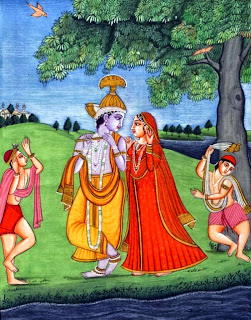
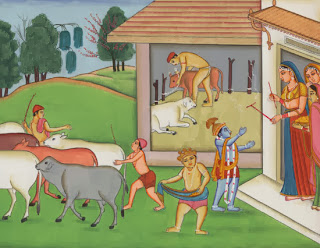
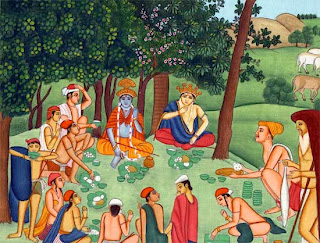
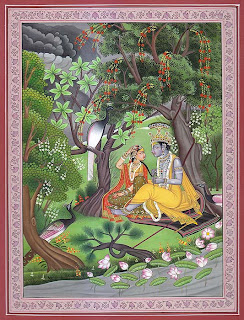










0 Response to "The Krishna Legend "
Post a Comment